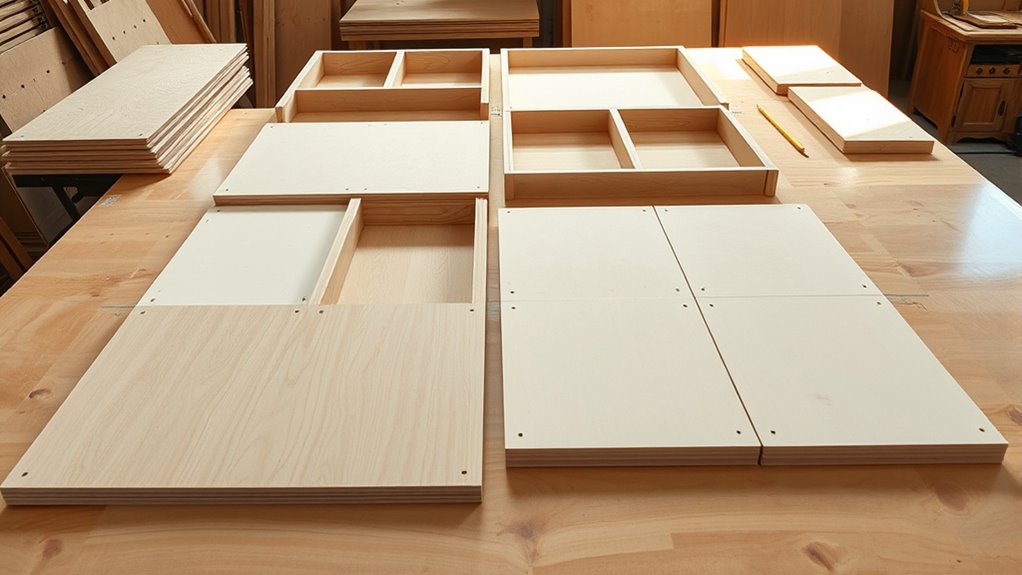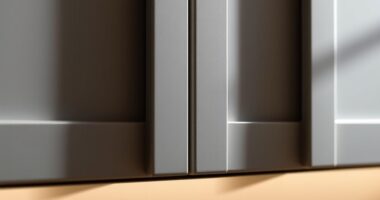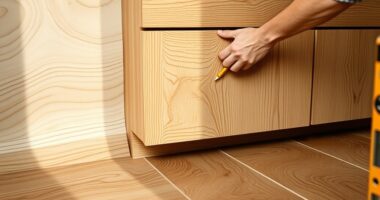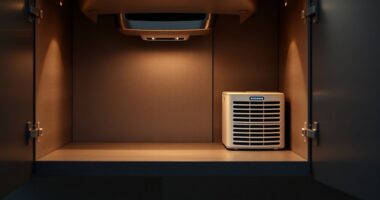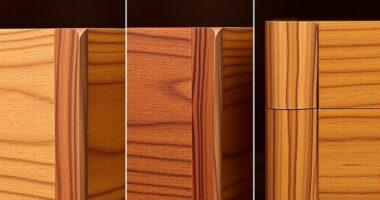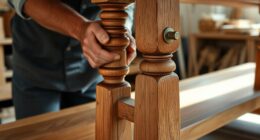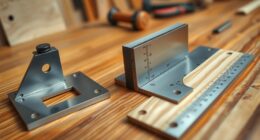To maximize sheet good yield in cabinet carcass layout, plan your parts carefully by analyzing project design and arranging pieces to minimize gaps. Consider grain direction, material properties, and kerf width to make sure parts fit precisely after cutting. Optimize the cutting sequence to reduce tool movement and waste, grouping similar cuts together. With effective layout planning, you’ll boost efficiency and reduce costs. Keep exploring to discover additional tips that can further enhance your nesting process.
Key Takeaways
- Analyze cabinet design to identify all panels and their dimensions before layout planning.
- Arrange large and narrow parts efficiently to maximize sheet material utilization and minimize waste.
- Optimize grain orientation and panel placement for strength, appearance, and nesting efficiency.
- Plan cutting sequences to reduce tool movement and streamline workflow, saving time and resources.
- Account for kerf width and material properties to ensure precise fitting and high nesting efficiency.
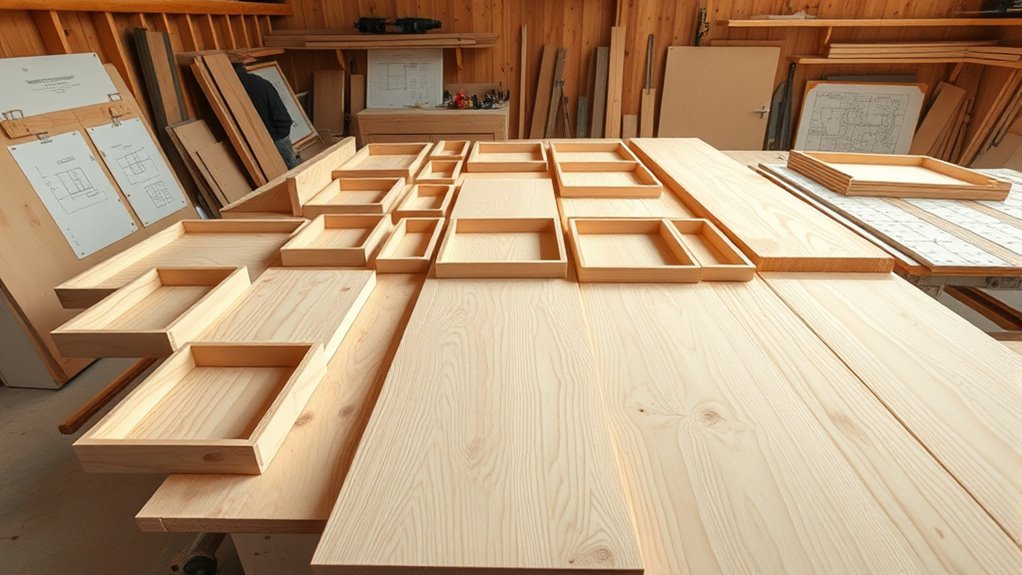
Designing a cabinet carcass layout is a crucial step that determines the strength, functionality, and efficiency of your finished piece. When you focus on panel optimization, you’re making sure every sheet of material is used to its fullest potential, reducing waste and saving costs. Achieving high cut list efficiency means carefully planning how each cut is made, aligning parts to minimize scrap and streamline your production process. This approach not only saves money but also speeds up assembly, as fewer irregular pieces mean less time spent sorting and fitting.
You should start by analyzing your project’s design and identifying all the panel components needed for the carcass. Break down each piece—sides, top, bottom, shelves—by their dimensions, and then look for ways to nest these parts on standard sheet sizes. Effective panel optimization involves arranging parts so they fit tightly together with minimal gaps, which helps you maximize each sheet’s yield. For example, positioning long, narrow pieces alongside larger panels can often reduce wasted space. Use software tools or sketch your layout on paper to experiment with different arrangements before making cuts. This ensures you achieve the highest cut list efficiency possible.
Another key factor is understanding the grain direction and material properties of your sheet goods. Orient your parts to run with the grain when necessary for strength or appearance, but also consider how this impacts nesting. Sometimes, adjusting the orientation of parts can open up more efficient nesting options, reducing waste further. Keep in mind that the kerf—cut width—also influences how closely parts can be nested. Accounting for the kerf ensures your parts fit precisely, preventing the need for re-cutting or adjustments later. Additionally, understanding the panel material properties can help you select the most suitable sheets and avoid issues like warping or splitting during cutting.
As you develop your layout, consider the sequence of cuts to avoid unnecessary tool movements and reduce overall processing time. Group similar cuts together and plan the order in which panels are cut to streamline your workflow. Remember, a well-thought-out layout not only improves panel utilization but also simplifies assembly, as parts will be more consistent and easier to fit together. When you calculate your cut list, double-check the dimensions and quantities, ensuring the plan aligns with your project specifications.
Frequently Asked Questions
How Does Material Grain Direction Affect Layout Efficiency?
You should consider grain alignment because it substantially impacts layout efficiency. Properly aligning the grain with your sheet’s flow reduces waste and makes better use of material. When you plan your cuts with the grain direction in mind, you optimize sheet usage, minimize defects, and improve overall yield. This careful attention to grain flow ensures your cabinet carcass layout is efficient, saving you both time and material costs.
What Tools Assist in Precise Cabinet Carcass Layout Planning?
Think of cutting software and layout templates as your trusty map and compass for precise cabinet carcass planning. These tools guide your cuts, ensuring minimal waste and maximum efficiency. Cutting software automates complex calculations, while layout templates help you visualize the best arrangement of sheet goods. Together, they act like a skilled navigator, steering your project straight to accuracy and ideal material use every time.
How Can Waste Be Minimized During Sheet Layout?
You can minimize waste during sheet layout by carefully considering panel orientation to maximize sheet usage. Use optimized cutting patterns that reduce offcuts and unnecessary cuts. Plan your layout to fit panels efficiently, avoiding gaps and overlaps. By analyzing your design and adjusting panel placement, you’ll guarantee better yield, reduce material costs, and create a more sustainable process. Always review your cutting plans before starting to catch potential waste.
What Are Common Mistakes in Cabinet Carcass Arrangement?
You often make mistakes in cabinet carcass arrangement by neglecting panel orientation, which can lead to increased waste and difficulty during assembly. Additionally, poor planning of the cutting sequence causes unnecessary cuts and material loss. To improve, guarantee panels are oriented correctly for maximum yield, and plan your cuts strategically to minimize waste. Double-check your layout before cutting to avoid costly errors and optimize sheet goods use.
How Does Cabinet Design Influence Overall Material Utilization?
Your cabinet design directly impacts material utilization by influencing panel orientation and joint placement. Properly aligning panels minimizes waste, allowing you to optimize sheet good usage. Thoughtful joint placement reduces the need for extra cuts and panel pieces, conserving materials. By planning your layout carefully, you ensure efficient use of sheet goods, cut down on waste, and save costs—all essential for a sustainable, economical cabinet project.
Conclusion
Now that you understand how a strategic cabinet carcass layout can maximize sheet good yields, imagine what’s possible when you apply these principles. Will your next project be more efficient, more cost-effective, and more impressive? The secret lies in the details of your layout choices. As you plan your cuts, a world of savings and craftsmanship awaits—are you ready to unseal its full potential? The next step could change everything.
